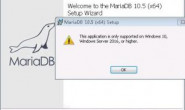Windows 7 系统 ,
计划把tmpdir 指向D:/MariaDB10.1/tmp 文件夹
打死也没修改过来。
求指点!
计划把tmpdir 指向D:/MariaDB10.1/tmp 文件夹
打死也没修改过来。
求指点!
mariadb> show variables like "tmpdir"; +--+--+ | Variable_name | Value | +--+--+ | tmpdir | C:\Windows\SERVIC~2\NETWOR~1\AppData\Local\Temp | +--+--+ 1 row in set
# Example MariaDB config file for large systems. # # This is for a large system with memory = 512M where the system runs mainly # MariaDB. # # MariaDB programs look for option files in a set of # locations which depend on the deployment platform. # You can copy this option file to one of those # locations. For information about these locations, do: # "my_print_defaults --help" and see what is printed under # Default options are read from the following files in the given order: # More information at: http://dev.mysql.com/doc/mysql/en/option-files.html # # In this file, you can use all long options that a program supports. # If you want to know which options a program supports, run the program # with the "--help" option. # The following options will be passed to all MariaDB clients [client] #password = 123456 port = 3306 socket = /tmp/mysql.sock default-character-set=utf8 # Here follows entries for some specific programs # The MariaDB server [mysqld] port = 3306 socket = /tmp/mysql.sock basedir=d:/MariaDB10.1 datadir=d:/MariaDB10.1/data default-character-set=utf8 default-storage-engine=MyISAM skip-external-locking key_buffer_size = 256M max_allowed_packet = 1M table_open_cache = 256 sort_buffer_size = 1M read_buffer_size = 1M read_rnd_buffer_size = 4M myisam_sort_buffer_size = 64M thread_cache_size = 8 query_cache_size= 16M log-slow-queries=/data/test/slow-query.log long_query_time=5 max_connections=1000 back_log=128 table_cache=512M # Try number of CPU"s*2 for thread_concurrency thread_concurrency = 8 # Point the following paths to different dedicated disks tmpdir=/tmp/ # Don"t listen on a TCP/IP port at all. This can be a security enhancement, # if all processes that need to connect to mysqld run on the same host. # All interaction with mysqld must be made via Unix sockets or named pipes. # Note that using this option without enabling named pipes on Windows # (via the "enable-named-pipe" option) will render mysqld useless! # #skip-networking # Replication Master Server (default) # binary logging is required for replication log-bin=mysql-bin # binary logging format - mixed recommended binlog_format=mixed # required unique id between 1 and 2^32 - 1 # defaults to 1 if master-host is not set # but will not function as a master if omitted server-id = 1 # Replication Slave (comment out master section to use this) # # To configure this host as a replication slave, you can choose between # two methods : # # 1) Use the CHANGE MASTER TO command (fully described in our manual) - # the syntax is: # # CHANGE MASTER TO MASTER_HOST=<host>, MASTER_PORT=<port>, # MASTER_USER=<user>, MASTER_PASSWORD=<password> ; # # where you replace <host>, <user>, <password> by quoted strings and # <port> by the master"s port number (3306 by default). # # Example: # # CHANGE MASTER TO MASTER_HOST="125.564.12.1", MASTER_PORT=3306, # MASTER_USER="joe", MASTER_PASSWORD="secret"; # # OR # # 2) Set the variables below. However, in case you choose this method, then # start replication for the first time (even unsuccessfully, for example # if you mistyped the password in master-password and the slave fails to # connect), the slave will create a master.info file, and any later # change in this file to the variables" values below will be ignored and # overridden by the content of the master.info file, unless you shutdown # the slave server, delete master.info and restart the slaver server. # For that reason, you may want to leave the lines below untouched # (commented) and instead use CHANGE MASTER TO (see above) # # required unique id between 2 and 2^32 - 1 # (and different from the master) # defaults to 2 if master-host is set # but will not function as a slave if omitted #server-id = 2 # # The replication master for this slave - required #master-host = <hostname> # # The username the slave will use for authentication when connecting # to the master - required #master-user = <username> # # The password the slave will authenticate with when connecting to # the master - required #master-password = <password> # # The port the master is listening on. # optional - defaults to 3306 #master-port = <port> # # binary logging - not required for slaves, but recommended #log-bin=mysql-bin # Uncomment the following if you are using InnoDB tables #innodb_data_home_dir = C:\mysql\data\ #innodb_data_file_path = ibdata1:10M:autoextend #innodb_log_group_home_dir = C:\mysql\data\ # You can set .._buffer_pool_size up to 50 - 80 % # of RAM but beware of setting memory usage too high innodb_buffer_pool_size = 1024M #innodb_additional_mem_pool_size = 20M # Set .._log_file_size to 25 % of buffer pool size #innodb_log_file_size = 64M #innodb_log_buffer_size = 8M innodb_flush_log_at_trx_commit = 2 #innodb_lock_wait_timeout = 50 [mysqldump] quick max_allowed_packet = 16M [mysql] no-auto-rehash # Remove the next comment character if you are not familiar with SQL #safe-updates [myisamchk] key_buffer_size = 128M sort_buffer_size = 128M read_buffer = 2M write_buffer = 2M [mysqlhotcopy] interactive-timeout [WinMySQLAdmin] Server=d:\MariaDB10.1\bin\mysqld.exe
解决方案
15
你这里有的路径是Windows,有的路径是Linux的,你确定你的MySQL可以正常启动?
15
LZ是在哪儿改的设置呢?
只看到这个,不是所说的指向D:/MariaDB10.1/tmp啊
只看到这个,不是所说的指向D:/MariaDB10.1/tmp啊




